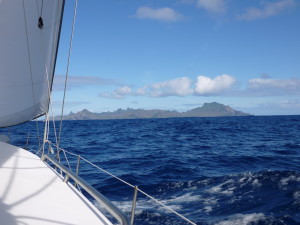They’re not often talked about, but I’m fascinated by rogue waves – waves that are much bigger than the rest of the sea around them, jumping up at you out of nowhere. Even the name suggests mischief and danger. I’ve witnessed what I’d call mini-rogues (basically waves that are noticeably larger than the average sea state) many times while out in the Pacific, usually during or near storm systems, but sometimes caused by storms hundreds or a thousand miles away. Proper “rogue waves” are less common, but more dramatic.
Definition (oceanography): Rogue waves, also known as freak waves, are not defined by their absolute size, but by their size relative to the surrounding sea state. They are more than twice the “significant wave height” (SWH) in the local area. Note that SWH is generally the average wave height reported by a trained observer (it’s called SWH because instruments measuring actual wave height show a complex distribution/range, making the term “average” difficult to define clearly).

There are two common types of “rogue wave”: one is a larger than average wave that seems to roll along the water for long distances. This kind was first described in 1834 by Scott Russell after he noticed one in the Union canal in Scotland and was able to reproduce it in a wave tank.
The other type, which is much more common from my experience on the open ocean, occurs when different wave systems interfere with each other and create a spike of water that stands noticeably above the average wave height. The larger the storm systems that create those different wave systems, the larger the rogues. There’s also a hole in the water somewhere not far from the rogue – but that’s usually difficult to see from any distance because it’s hidden by other waves. Strangely (I think) research into rogue waves doesn’t tend to mention the hole. There’s a fair amount of research (especially Peregrine solitons) to understand how these large waves can seemingly come out of nowhere on the ocean, and how to design ships and offshore structures to survive encounters with the exceptionally large waves.
I recall watching a cyclonic system that passed north of us while sailing in the Southern Ocean east of New Zealand. One of those weather troughs that seem to revolve around Antarctica, projecting finger-like up into the more tropical latitudes, was also approaching. These two systems sent large wave trains at us, surrounding the boat with mini-rogues. When the days were clear, we could scan the horizon and be sure to see one at least every minute, with the occasional one crashing over the boat every hour or so. They are more frequent when the wave trains are of similar size, since a dominant wave system dwarfs others and the resulting interference pattern is not significantly higher than the larger waves.
Rogue waves were actually considered a myth until one was finally recorded in 1995 by equipment on a Norwegian platform about halfway between Norway and Scotland in the North Sea. In this particular case, the SWH was 12 m (39 ft) and the rogue was 25.6 m (84 ft) – but those measurements are peak to trough. If one compares the rogue peak to an average (SWH) wave peak, it’s 12.5 m (41 ft) higher, or about three times higher than the SWH peak!

While sailing along the eastern reef of Rapa Iti (the Southeast-most island in the Australs, part of French Polynesia), approaching the entrance to the harbour, we experienced a mini-rogue hole-like trough open up under Illusion. For about half a second, there was no water under us! Sailing in large seas can be noisy, so it was weird to have that short pause of silence while falling into the trough. Imagine a 20 ton boat dropping about 2 meters onto the water – our splash-down was quite dramatic. We hit the water at something like 20 km/h – everything shook, buzzing for a few seconds as the vibrations settled.

Two of my crew were down below and didn’t know what was happening, except that they were free-falling, then thrown about after the hard landing. My other crew was in the cockpit with me and she was thrown around as well. I was steering, suddenly saw the water open up under us, and had just enough time to tighten my grip for the crash landing, but unfortunately not enough time to warn the others!
There are many anecdotal stories of boats being battered by rogue waves and a few large ships lost at sea, presumably because they didn’t survive damage inflicted by a rogue. The MS München is one of those large ships that met a sad ending in 1978, but survived long enough to transmit limited information about its demise.
My own experiences have been memorable, but I’d be happy to not have to meet any of these bad guys again! How about you, has anyone else noticed how common these mini-rogue waves seem to be? Or have a dramatic rogue wave experience to share?

